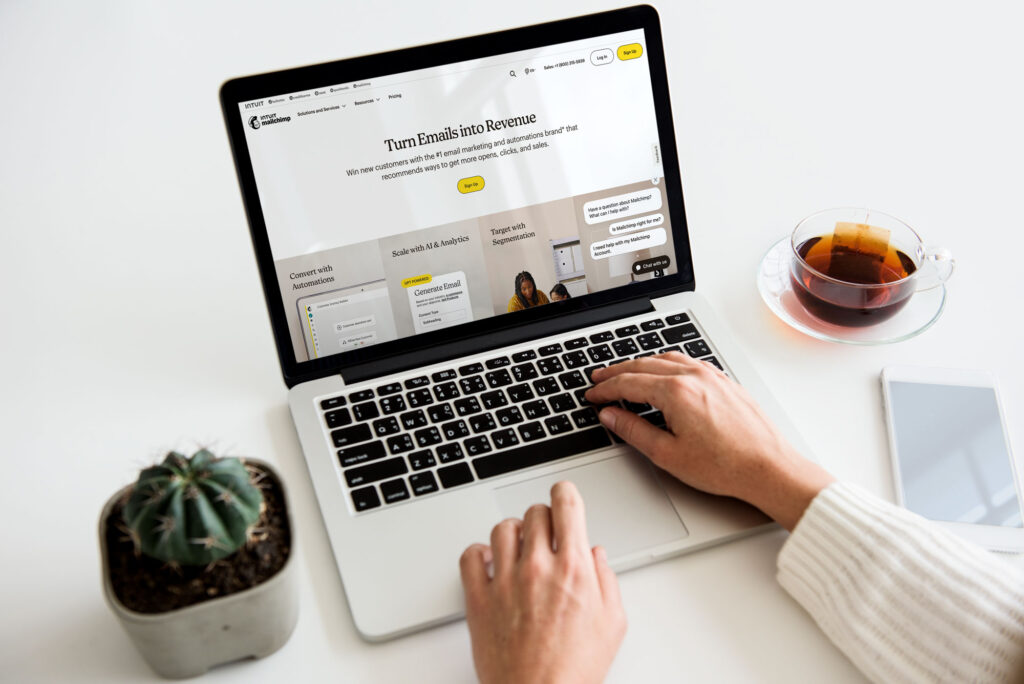In an age dominated by social media and digital marketing, newsletters may seem a bit outdated. However, they remain one of the most potent tools in a small business owner’s arsenal for audience growth and engagement. I’ve recently discussed this topic with a couple of my clients, and I thought it would be useful to make an article covering relevance, benefits, and how you can reach a wider audience and foster lasting customer relationships.
Are newsletters still relevant?
Let’s start by looking at some statistics:
- Over 1 billion Stories get posted every day across Facebook apps.
- More than 25 million businesses use Instagram to promote their services and products
- On average, people watch over a billion hours of video and generate billions of views on YouTube daily.
In an era where TikTok videos go viral in seconds and social media feeds are inundated with content, you might wonder if email newsletters still have a place in the marketing toolkit, especially for small businesses. The truth is, newsletters remain not only relevant, but also valuable for big and small businesses looking to connect with their audience in a meaningful and sustainable way.
They provide a direct and personal connection. When you send out a newsletter, it lands directly in your subscribers’ email inboxes. This level of direct access to your audience is unparalleled in the world of digital marketing (except only for the new emerging AI to user connection). And with some personal touches added you can build a strong rapport with your subscribers, fostering trust and brand loyalty over time.
With newsletters, you have full ownership and control over your subscriber list. This means that no algorithm changes or platform policies can suddenly reduce your reach or access to your audience. Your subscriber list is an asset that can be nurtured and leveraged for building trust and long-term success.
And speaking of trust: trust is a cornerstone of successful marketing, and newsletters excel in building trust. When subscribers willingly provide their email addresses and invite you into their inboxes, it signifies a level of trust and interest in your brand.
And while acquiring new customers is important, retaining existing ones is equally crucial. Through newsletters, you can provide your subscribers with updates, offers, and exclusive content that keeps them interested in your brand. This ongoing engagement can lead to repeat business and even turn one-time customers into loyal advocates for your small business (can you say micro-influencers?).
For small businesses with limited budgets, newsletters offer a cost-effective marketing solution. Compared to many other marketing channels, email marketing is often more affordable. There are various email marketing platforms available, many of which offer free or low-cost plans for businesses just starting.
Getting started with newsletters
Some of my clients are considering adding newsletters to their strategy, but don’t really know where to start. So I usually give them the following pointers, which include: selecting the right email marketing platform, crafting compelling content that captivates your subscribers and monitoring the situation after the newsletters are sent.
And since I’m not in the habit of gatekeeping, here is how I would suggest getting started with newsletters for your small company:
Define your newsletter goals
Before you dive into creating a newsletter, it’s crucial to define your goals. What do you hope to achieve with your newsletter? Are you aiming to:
- increase sales?
- drive website traffic?
- build brand awareness?
Understanding your objectives will shape your content strategy and help you measure success later.
Choose the right email marketing platform
Selecting the right email marketing platform is another major decision. My favorites to recommend are MailChimp, Constant Contact, and Brevo (formerly SendinBlue) since they offer user-friendly interfaces and various features suitable for small businesses. And with the need for coding being kept to a minimum, you can focus your efforts and create engaging content. The platforms also provide multiple implementations of subscription forms, so you can choose the right one for your communication strategy.
When choosing the perfect platform for your small business think about:
- ease of use
- pricing
- scalability
- integration options.
Build your subscriber list
A quality subscriber list is the lifeblood of your newsletter. Start by collecting email addresses from your existing customers and website visitors, but don’t forget about local laws!
Email marketing is subject to regulations like the CAN-SPAM Act in the United States and the GDPR in Europe. Familiarize yourself with these regulations and ensure your newsletter complies. This includes providing a clear way for subscribers to opt out, including your physical address, and not using deceptive subject lines.
Create signup forms on your website and social media profiles to encourage new subscribers and emphasize the value people will receive from your newsletter. You can also use promotions to incentivize signups.
Craft compelling content
The heart of your newsletter is its content. Make sure it’s informative, relevant, and valuable to your subscribers. Create attention-grabbing subject lines to entice recipients to open your emails (PS: some newsletter platforms will also help with this). Use concise, scannable text with clear headings, and include compelling visuals like images and videos.
And finally, be sure to adapt your content so it will fit with the rest of your content strategy. Even small businesses should try to keep a clean and clear strategy for communicating their goals and keep resonating with the target audience. Consider the following elements:
- Content Types: Decide what type of content you’ll include, such as industry news, product updates, customer stories, or exclusive offers.
- Frequency: Determine how often you’ll send your newsletter. Maintaining a consistent approach is crucial, but it’s important to strike a balance and avoid overwhelming your subscribers.
- Personalization: Tailor your content to different segments of your audience based on their interests and behaviors.
- Engagement: Encourage interactivity through surveys, polls, or calls to action (CTAs).
Design eye-catching newsletters
Your newsletter’s design should be visually appealing. Most email marketing platforms offer customizable templates, making it easier to create professional-looking emails. Use a clean layout, incorporate your brand colors and logo, and keep the design clutter-free.
A sizeable portion of email opens occurs on mobile devices, so it’s essential to ensure your newsletters are mobile-friendly. Test your emails on various devices to ensure they display correctly and are easy to navigate.
Test and preview
Before sending your newsletter to your entire list, test it by sending previews to yourself and team members. Check for formatting issues, broken links, and typos to ensure all elements are working as intended.
You can also use segmentation at this stage, to send specific messages to different groups based on characteristics like demographics, behavior, or purchase history.
Monitor, analyze and improve on each iteration
Once your newsletter is live, pay close attention to performance metrics. Email marketing platforms provide data on open rates, click-through rates, and conversion rates. Use these insights to refine your content strategy and improve engagement. Continuous improvement is key to newsletter success. Analyze the data, gather feedback from subscribers, and iterate on your content and design. Experiment with different approaches to see what resonates best with your audience.
Follow the points above and start creating newsletters that help your business strategy. Because when leveraged effectively, newsletters can be a powerhouse for audience growth, trust-building, and long-term success.
Using newsletters for small business success
Let’s say you’ve followed the indications above already, but you still don’t know exactly how to make your newsletters stand out, reach a bigger audience and, more importantly, grow your small business sales. Well, I have a couple of tips and tricks for that as well since some of my clients already struggled with these exact things.
 Leveraging exclusive content
Leveraging exclusive content
One of the most effective ways to grow your newsletters audience is by leveraging exclusive content. Provide your subscribers with something they can’t find elsewhere. This could be premium content, early access to new products or services, or even members-only discounts.
Exclusive content creates a sense of belonging among your subscribers, making them more likely to remain loyal and refer to others. The psychology behind this strategy is simple: people love feeling special, and offering them something exclusive fosters a stronger connection between your brand and your audience.
Cross-Promotions and Collaborations
Collaborations and cross-promotions with other businesses or influencers can significantly expand your newsletter’s reach. Partner with complementary businesses in your industry or niche to reach their audiences.
For example, if you run a fitness equipment store, collaborate with fitness trainers or nutritionists to co-create content and promote it to both your subscriber lists. This strategy not only introduces your brand to a new audience but also builds credibility through association with trusted partners.
Referral Programs
Referral programs can be a powerful tool for audience growth. Encourage your existing subscribers to refer friends, family, or colleagues to join your newsletter in exchange for incentives such as discounts, freebies, or exclusive content. Make the referral process straightforward and rewarding. When your subscribers become advocates for your newsletter, your audience can grow exponentially, and the new subscribers often come with a higher level of trust, thanks to the endorsement from someone they know.
Social Media Integration
Integrating your newsletter with your social media channels can amplify your efforts. Promote your newsletter on your social profiles and encourage your followers to subscribe. Similarly, include social media share buttons within your newsletters to make it easy for subscribers to share your content with their networks. Social media platforms can act as a funnel for directing traffic to your newsletter signup page, expanding your reach and potentially converting social media followers into engaged email subscribers.
Giveaways and Contests
Organizing giveaways and contests exclusively for your newsletter subscribers can be a fun and effective way to attract new sign-ups. Promote these events on your website, social media, and other marketing channels to capture the attention of potential subscribers. Make sure the prizes or rewards are relevant and valuable to your target audience. During these events, encourage participants to share their participation with their network, effectively turning your subscribers into advocates for your brand.
Guest Contributions
Inviting guest contributors to contribute content to your newsletter can bring fresh perspectives and new audiences. Reach out to influencers or experts in your industry and ask them to create content or provide insights for your newsletter. Their involvement not only adds value to your content but also exposes your newsletter to their followers, who may be interested in your content and subscribe for more.
Webinars and Events
Promote webinars, workshops, or virtual events through your newsletter. Hosting these events and offering exclusive access to subscribers can attract a dedicated audience interested in your industry or niche. Additionally, use your newsletters to announce and recap these events, keeping subscribers engaged and informed.
Key takeaways
By implementing these audience growth strategies through newsletters, you can not only expand your subscriber base but also build a more engaged and loyal audience. Remember that growing your audience takes time and persistence, so be patient and consistently deliver value to your subscribers to foster lasting relationships.
When leveraged effectively, newsletters can be a powerhouse for audience growth, trust-building, and long-term success. Whether you’re just starting or looking to revamp your existing newsletter strategy, let me know if the pointers above had an impact.







